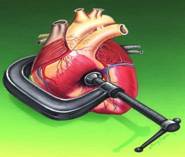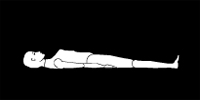INTRODUCTION
Pulmonary arterial hypertension is a progressive disorder characterized by abnormally high blood pressure (hypertension) in the pulmonary artery, the blood vessel that carries blood from the heart to the lungs. Hypertension occurs when most of the very small arteries throughout the lungs narrow in diameter, which increases the resistance to blood, flow through the lungs.

YOGA AND HYPERTENSION
Yoga is an ancient system of self-development, which offers a holistic approach to man through its ideology & techniques. In the modern age of advanced technology, people have lost their ability to recognize sickness at its subtle level. Yoga makes us realize that disease affecting any specific part of our body is not really a disease confined only to that part but in fact, it is a manifestation of some disharmony in the body-mind complex of the whole personality.

YOGA POSES FOR HYPERTENSION
Easy Pose
This is one of the classic Meditative Poses and is usually performed after doing the Corpse Pose. The Easy Pose helps in straightening the spine, slowing down metabolism, promoting inner tranquility, and keeping your mind still.
Shoulder Stretches
Shoulder Stretches are great in relieving stress and tension on your shoulders, as well as your entire upper back. Practice them daily for several weeks and notice the changes
Stand Spread Leg Forward Fold
Practicing the Standing Spread Leg Forward Fold can strengthen and stretch your inner and back legs and your spine. People with lower back problems should avoid doing the full forward bend. For beginners, you may use props like a folding chair to support your forearms.
Cat Pose
The Cat Yoga Pose teaches you to initiate movement from your center and to coordinate your movement and breath. These are two of the most important themes in Yoga practice. Keep in mind that the Cat Pose may not be advisable if you have any chronic or recent back pain or injury.
Half Spinal Twist
If done properly, the Half Spinal Twist lengthens and strengthens the spine. It is also beneficial for your liver, kidneys, as well as adrenal glands. Practice this Yoga Pose under the supervision of a Yoga instructor. In this section, learn how to perform the Half Spinal Twist.
Wind Relieving Pose
The term Pavanamuktasana comes from the Sanskrit word 'pavana' which means air or wind and 'mukta' which means freedom or release. The Wind Relieving Pose works mainly on the digestive system. Specifically, it helps in eliminating excess gas in the stomach.
Double Leg Raises
A Double Leg Raise is similar to a Single Leg Raise, only this time, you will raise both legs. In doing this Yoga Pose, make sure that the full length of your back is resting on the floor and your shoulders and neck are relaxed.
Anuloma Viloma
Anuloma Viloma is also called the Alternate Nostril Breathing Technique. In this Breathing Technique, you inhale through one nostril, retain the breath, and exhale through the other nostril. Learn how to do this technique for beginners by following the steps found in this article.
YOGA ASANAS FOR HYPERTENSION
SHAVASANA

Shavasana helps to bring down high blood pressure (arterial hypertension) and gives immense relief to the mind (any individual who has been restricted from doing other asanas due to high blood pressure can perform this asana). It also helps ease tension and stress for those involved in physical activities.
Steps
• Lie flat on the back, feet comfortably apart, arms and hands extended about 6 away from the body, palms facing upwards with half-folded fingers.
• Close your eyes and gently relax your feet, keeping them completely still. Then relax your knees, chest and the arms. Keep both your hands still to achieve a relaxed position. Concentrate next on the head. Move it gently to the side, let it rest and keep it free of all thoughts.
• Then concentrate the mind on rhythmic breathing. Breathing should be as slow and as effortless as possible. Thus, all parts of the body are loosened to create a state of complete relaxation, which should be maintained for 10 to 15 minutes.
TALASANA (PALM TREE POSE)

A very good exercise for the lungs as it massages every air sac and strengthens them. It is also useful in treating hypertension, heart disease, arthritis, bronchitis, and backache and shoulder pain. Tala" means "palm tree" in Sanskrit. In this posture, the body is held upright like the trunk of a palm tree. Hence the name.
Steps
• Stand erect. Keep your feet slightly turned out and sufficiently apart according to your height and build. Look straight ahead.
• Inhaling, slowly raise your arms overhead with the palms facing each other.
• Raise your heels slowly, keeping your balance.
• Lift yourself on your toes slowly until you stand on tiptoe.
• Exhale slowly and keep balance. Inhale slowly again.
• Balancing the body on tiptoe, pull up and stretch your arms upwards from the shoulder-blades with the fingers outstretched.
• Raise your heels also simultaneously as high as possible and stretch your body to the maximum.
• Stretch your neck and head backwards and look up.
• Hold your breath and keep your balance. Keep yourself firmly in this position as long as you can hold your breath comfortably.
• Exhaling, relax the body and return to the starting position by slowly lowering the arms and heels simultaneously, bending the neck and head forward.
ASTROLOGY
A unique characteristic of Indian astrology are the yoga's. Yoga's are planetary positions that lead to a certain result. Yoga is a term for good fortune and unless specified otherwise, a yoga is a good yoga. Yoga is a particular placement or combination of planets, which collectively raise the fortunes of a person, which cannot be deciphered by individual study of placement of participating planet. According to astrological reports for yoga asanas the above mentioned asanas are said to be effective for those who come under the following zodiac sign.
• TAURUS
• LEO
• PISCES